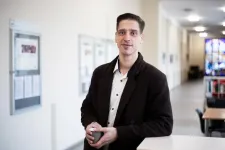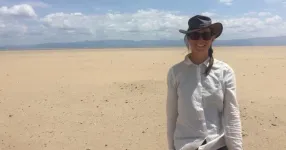(Press-News.org) Cave divers collected 78 water samples throughout the complex web of underwater caves
Researchers found the cave system’s microbiome is distinct from the nearby sea
Microbial communities vary between cave systems forming distinct “neighborhoods”
EVANSTON, Ill. — With help from an experienced underwater cave-diving team, Northwestern University researchers have constructed the most complete map to date of the microbial communities living in the submerged labyrinths beneath Mexico’s Yucatán Peninsula.
Although previous researchers have collected water and microbial samples from the cave entrances and easily accessible sinkholes, the Northwestern-led team reached the deep, dark passageways of unlit waters to better understand what can survive inside this unique underground realm.
After analyzing the samples, the researchers noted a system rich with diversity, organized into distinct patterns. Similar to a stereotypical high school lunchroom, microbial communities within the cave system tend to cluster into well-defined cliques. But one family of bacteria (Comamonadaceae) acted as a popular social butterfly — appearing at nearly two-thirds of the “cafeteria tables.” The findings hint that Comamonadaceae is the ecological linchpin of the broader community.
The research was published late last week (Nov. 2) in the journal Applied and Environmental Microbiology.
“This is certainly the most expansive microbial survey across this part of the world,” said Northwestern’s Magdalena R. Osburn, who led the study. “These are incredibly special samples of underground rivers that are particularly difficult to obtain. From those samples, we were able to sequence the genes from microbial populations that live in these sites. This underground river system provides drinking water for millions of people. So, whatever happens with the microbial communities there has the potential to be felt by humans.”
A geobiology expert, Osburn is an associate professor of Earth and planetary sciences at Northwestern’s Weinberg College of Arts and Sciences. Northwestern alumnus Matthew Selensky led this project as a part of his dissertation when he was a graduate student in Osburn’s laboratory. Study co-author Patricia Beddows,professor of Earth and planetary sciences at Weinberg, led the cave-diving expedition and leveraged her decades of experience working on these caves. Other Northwestern co-authors include Andrew Jacobson, professor of Earth and planetary sciences, and former graduate student Karyn DeFranco, who focused on the geochemistry.
Located primarily in southeastern Mexico, the extensive Yucatán carbonate aquifer is pockmarked by numerous sinkholes leading to a complex web of underwater caves. Hosting a diverse, yet understudied microbiome, the underwater network contains areas of freshwater, seawater and mixtures of both. The system also includes a variety of zones — from pitch-black, deep pits with no direct openings to the surface to shallower sinkholes sparkling with sunlight.
“The Yucatan platform is essentially a Swiss cheese of cave conduits,” Osburn said. “We were curious which microbes are found together when we look across the whole system versus which microbes are found within one ‘neighborhood.’”
To explore this question, a team of cave divers collected 78 water samples from 12 individual sites within the cave system near the Caribbean coast in Quintana Roo, Mexico. The sample collection spanned from the Xunaan Ha system at the north end to inland and coastal portions of the Sac Actun system (including a distinctive, 60-meter-deep pit) to the Ox Bel Ha system to the south.
Back in a dive-shop-turned-science lab, researchers filtered cells out of each sample and analyzed its chemistry. Next, back at Northwestern, they identified microbial communities by sequencing their DNA. Then, Selensky developed a new computational program to perform network analysis on the data set. The resulting networks showed which species tend to live together. For each site, the researchers considered the environmental context of each microbial community, including cave type (pit or conduit), cave system, distance from the Caribbean coast, geochemistry and position in the water column.
Although water from the Gulf of Mexico flows into the Yucatán aquifer, the aquifer’s microbiome varies substantially from the nearby sea, the researchers found. The microbiomes also vary throughout the cave system — from cave to cave and from shallow water to deep water.
“The microbial communities form distinct niches,” Osburn said. “There is a varying cast of characters that seem to move around, depending on where you look. But when you look across the whole data set, there’s a core set of organisms that seem to be performing key roles in each ecosystem.”
Osburn and her team found that Comamonadaceae, a family of bacteria typically found in groundwater systems, lived in several niches. They also discovered that a deep, pit-like sinkhole with a surface opening (allowing sunlight to spill in) housed the most microbial communities — segregated into layers of distinct niches throughout the water column.
“It seems that Comamonadaceae performs slightly different roles in different parts of the aquifer, but it’s always performing a major role,” Osburn said. “Depending on the region, it has a different partner. Comamonadaceaeand its partners probably have some mutualistic metabolism, maybe sharing food.”
The study, “Microbial biogeography of the eastern Yucatán carbonate aquifer,” was supported by the David and Lucile Packard Foundation and the Canadian Institute for the Advancement of Research.
END
Most of us understand that electrical engineering and mechanical engineering play a key role in running our washing machines or our computers. But did you know that more than 80 percent of the products we use every day, such as fertilizers, cosmetics, fragrances, rubber and more, require some sort of chemical catalyst while being manufactured?
Catalysts are like turbochargers for chemical reactions. Until now, the process of designing a catalyst for chemical reactions has been mostly trial ...
ATLANTA — New research at ACR Convergence 2023, the American College of Rheumatology’s (ACR) annual meeting, found that rheumatoid arthritis (RA) patients in sustained remission who stopped TNF inhibitors (TNFi) had significantly more flares and lower Boolean 2.0 remission rates compared with those who continued treatment. Boolean 2.0 is a revised definition for evaluating disease activity in RA that classifies more patients as achieving remission than Boolean 1.0. It is endorsed by the American College of Rheumatology and the European Alliance for Associations in Rheumatology (EULAR) (Abstract #L07).
As more RA patients ...
ATLANTA — New research at ACR Convergence 2023, the American College of Rheumatology’s (ACR) annual meeting, shows that patients with refractory juvenile systemic sclerosis improved significantly on nearly all measures for two years following autologous stem cell transplant (Abstract #L06).
Juvenile-onset systemic sclerosis (jSSc), also called scleroderma, is a disfiguring autoimmune disorder marked by hardening of the skin and internal organs, including the digestive tract, lungs, musculoskeletal system, kidneys and heart. The psychological and physical effects of the disease persist into adulthood, and many patients have a shortened lifespan. Effective ...
Using data from over 900 participants in a large, diverse, and national sample of Canadian adolescents and young adults from the Canadian Study of Adolescent Health Behaviors, a new study published in the journal Sexual Health researchers found significant associations between sex work and muscle dysmorphia.
Sex work, in its various forms, is highly stigmatized in Canadian society, and sex workers are often victims of harmful stereotypes. It is estimated that roughly 4% of Canadian adolescents engage in selling sex, and research has shown that those involved in sex work are more at risk to experience substance use ...
Neurodegenerative diseases like Alzheimer’s and Parkinson’s can be associated to depression and anxiety. Dr. Sabine Krabbe, a neuroscientist at DZNE’s Bonn site, is receiving 1.2 million US dollars from the Chan Zuckerberg Initiative to understand the mechanisms involved in the onset of these syndromes. To this end, she aims to examine the function of the brain’s “emotion center” using new methodologies to examine the function of single cells in experimental mouse models. The study will run for four ...
About The Study: Black women who reported experiences of interpersonal racism in situations involving employment, housing, and interactions with police appeared to have an increased risk of stroke, even after accounting for demographic and vascular risk factors, according to the results of this study including 48,000 Black women. These findings suggest that the high burden of racism experienced by Black U.S. women may contribute to racial disparities in stroke incidence.
Authors: Shanshan Sheehy, Sc.D., of Boston University, is the corresponding author.
To ...
About The Study: Maternal mRNA vaccination was associated with a lower risk of Omicron SARS-CoV-2 infection among infants up to six months of age only if the vaccine was given during the antenatal period in this study of 7,292 infants in Singapore. These findings suggest that mRNA vaccination during pregnancy may be needed for lower risk of SARS-CoV-2 infection among newborns.
Authors: Orlanda Goh, M.B., B.S., M.P.H., of Singapore General Hospital in Singapore, and Chee Fu Yung, M.B.Ch.B., of KK Women’s and Children’s ...
What can we expect in the worst-case scenario? In regions with a high risk of flooding, this is an important question: what extreme events should the protective measures be designed for? Often this is answered simply by looking at history: The worst flood events of the past decades or centuries are regarded as a realistic upper limit for what can be expected in the future.
However, this can be misleading, as so-called "mega-floods" have shown in recent years. Time and again, extreme flood events occur, extraordinary outliers that were not considered possible on the basis of local data. However, a major research project carried out under the leadership ...
“The world isn’t doing terribly well in averting global ecological collapse,” says Dr Florian Rabitz, a researcher at Kaunas University of Technology (KTU), Lithuania, the author of a new monograph Transformative Novel Technologies and Global Environmental Governance recently published by Cambridge University Press.
Greenhouse gas emissions, species extinction, ecosystem degradation, chemical pollution, and more are threatening the Earth’s future. Despite decades of international agreements and countless high-level ...
A leading researcher has been awarded a prestigious Royal Society Fellowship worth over £1.4 million to study how dryland landscapes respond to a changing climate.
Dr Monika Markowska will join Northumbria University in January 2024 as part of her Royal Society University Research Fellowship. The Royal Society is the world’s oldest independent scientific academy, bringing together many of the world’s most distinguished scientists drawn from all areas of science, engineering, and medicine.
Specialising in the variability of the Earth’s past climate, Dr Monika Markowska is an Isotope Geochemist, who is currently based at Max Planck ...




